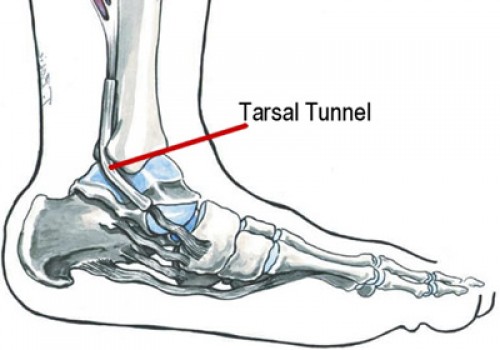The tarsal tunnel is a narrow space that lies on the inside of the ankle next to the ankle bones. The tunnel is covered with a thick ligament that protects and maintains the structures contained within the tunnel, arteries, veins, tendons, and nerves. One of these structures is the posterior tibial nerve, which is the focus of tarsal tunnel syndrome
The posterior tibial nerve is the nerve that runs along the inside of the ankle into the foot. Compression or squeezing of this nerve produce symptoms anywhere along the path of the nerve. Tarsal tunnel syndrome is similar to carpal tunnel in the wrist as both disorders stem from nerve compression in a confined space.
Patients with tarsal tunnel syndrome report varying types of symptoms that include electric shock-like sensations on the inside of the ankle and/or on the bottom of the foot. Some patients experience numbness, a sense of the foot “giving away”, and pain radiating up into the leg, arch, heel, and/or toes. Symptoms often occur at rest, and before trying to sleep at night.
Tarsal Tunnel Syndrome may be caused by various reasons:
- Cysts or benign tumors pressing on the nerve
- Varicose veins
- Arthritis
- Diabetes
- Injuries such as an ankle sprain or fracture
- Swollen tendon
- Flat feet
- New athletic activity
- Compensating for other foot or leg pain
Treatment
There are various forms of treatment depending on the severity of your condition.
Dr. Hausen will examine the foot to determine if there is any loss of feeling and if a mass is present. Sometimes an MRI or nerve conduction test may be ordered.
Mild to moderate cases of Tarsal Tunnel Syndrome may be treated by:
- Rest
- Oral medications
- Custom orthotics
- Immobilization
- Bracing
- Injection therapy
Surgery
Sometimes surgery is the best option for treating tarsal tunnel syndrome. Dr. Hausen will determine if surgery is necessary and will select the appropriate procedure or procedures based on the cause of the condition.

